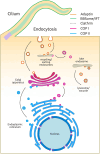Evolutionary trajectory for nuclear functions of ciliary transport complex proteins
- PMID: 38995044
- PMCID: PMC11426024
- DOI: 10.1128/mmbr.00006-24
Evolutionary trajectory for nuclear functions of ciliary transport complex proteins
Abstract
SUMMARYCilia and the nucleus were two defining features of the last eukaryotic common ancestor. In early eukaryotic evolution, these structures evolved through the diversification of a common membrane-coating ancestor, the protocoatomer. While in cilia, the descendants of this protein complex evolved into parts of the intraflagellar transport complexes and BBSome, the nucleus gained its selectivity by recruiting protocoatomer-like proteins to the nuclear envelope to form the selective nuclear pore complexes. Recent studies show a growing number of proteins shared between the proteomes of the respective organelles, and it is currently unknown how ciliary transport proteins could acquire nuclear functions and vice versa. The nuclear functions of ciliary proteins are still observable today and remain relevant for the understanding of the disease mechanisms behind ciliopathies. In this work, we review the evolutionary history of cilia and nucleus and their respective defining proteins and integrate current knowledge into theories for early eukaryotic evolution. We postulate a scenario where both compartments co-evolved and that fits current models of eukaryotic evolution, explaining how ciliary proteins and nucleoporins acquired their dual functions.
Keywords: cell biology; cilia; eukaryogenesis; eukaryotes; evolution; intraflagellar transport; last eukaryotic common ancestor; molecular biology; nuclear pore complex; nucleus.
Conflict of interest statement
The authors declare no conflict of interest.
Figures





Similar articles
-
A cross-species analysis of neuroanatomical covariance sex differences in humans and mice.Biol Sex Differ. 2025 Jul 1;16(1):47. doi: 10.1186/s13293-025-00728-1. Biol Sex Differ. 2025. PMID: 40598550 Free PMC article.
-
Short-Term Memory Impairment.2024 Jun 8. In: StatPearls [Internet]. Treasure Island (FL): StatPearls Publishing; 2025 Jan–. 2024 Jun 8. In: StatPearls [Internet]. Treasure Island (FL): StatPearls Publishing; 2025 Jan–. PMID: 31424720 Free Books & Documents.
-
How lived experiences of illness trajectories, burdens of treatment, and social inequalities shape service user and caregiver participation in health and social care: a theory-informed qualitative evidence synthesis.Health Soc Care Deliv Res. 2025 Jun;13(24):1-120. doi: 10.3310/HGTQ8159. Health Soc Care Deliv Res. 2025. PMID: 40548558
-
Factors that influence parents' and informal caregivers' views and practices regarding routine childhood vaccination: a qualitative evidence synthesis.Cochrane Database Syst Rev. 2021 Oct 27;10(10):CD013265. doi: 10.1002/14651858.CD013265.pub2. Cochrane Database Syst Rev. 2021. PMID: 34706066 Free PMC article.
-
Adapting Safety Plans for Autistic Adults with Involvement from the Autism Community.Autism Adulthood. 2025 May 28;7(3):293-302. doi: 10.1089/aut.2023.0124. eCollection 2025 Jun. Autism Adulthood. 2025. PMID: 40539213
References
Publication types
MeSH terms
Substances
Grants and funding
LinkOut - more resources
Full Text Sources

